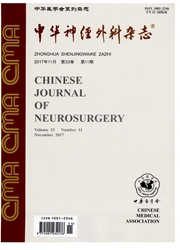

 中文摘要:
中文摘要:
目的探讨经眉弓眶上锁孔入路治疗脑脊液鼻漏的病例选择、手术方法及临床价值。方法回顾性分析2012年4月~2015年3月首都医科大学附属北京天坛医院收治的15例漏口位于额窦后壁的脑脊液鼻漏患者的临床资料,15例患者均行手术修补瘘口,其中5例经眉弓眶上锁孔入路,10例经冠状切口经额下入路。观察比较两种不同入路患者的治疗效果、手术时间、术中出血量及术后住院时间。结果本组15例患者均经1次手术修补成功,1例眉弓入路和3例冠切入路患者术后出现额部麻木,患者随访9~48个月,平均(26.4±14.0)个月,均未复发。经眉弓入路患者的平均手术时间[(3.5±0.4)h]及术中出血量[(72.0±19.2)mL]均少于经冠切入路患者[(5.8±1.7)h、(301.0±34.5)mLl,差异均有高度统计学意义(P=0.002、0.000)。经眉弓入路患者的术后住院时间为5~8d(中位数为6d),经冠切入路患者的术后住院时间为7~12d(中位数为8d)。结论经眉弓眶上锁孔入路具有损伤小、恢复快、住院时间短等优点,对于治疗漏口位于额窦后壁的患者具有优势。
 英文摘要:
英文摘要:
Objective To investigate the proper case selection, microsurgery technique and clinical value of trans- supraorbital keyhole approach for repairing cerebrospinal fluid rhinorrhea. Methods Clinical data of 15 patients with cerebrospinal fluid rhinorrhea resulting from fistulas on the posterior wall of frontal sinus in Beijing Tiantan Hospital, Capital Medical University from April 2012 to March 2015 were analyzed retrospectively. Supraorbital keyhole ap- proach was performed on 5 patients, and coronal subfrontal approach was performed on 10 patients. The treatment re- sults, operation time, operation blood loss and the postoperative hospital stay time of the patients were compared statis- tically betwen the two different approaches. Results After the operation, all patients recovered well and they were free of the CSF rhinorrhea. One patient that received the supraorbital keyhole approach and 3 patients that received the coronal subfrontal approach got postoperative forehead numbness. No patients got CSF rhinorrhea recurrence after a follow-up of 9-48 months, and the mean time was (26.4±14.0) months. During the operation, operation time of patients that received the supraorbital keyhole approach [(3.5±0.4) h] was less than patients who received the coronal subfrontal approach [(5.8±1.7) h], blood loss of patients undergone the supraorbital keyhole approach [(72.0±19.2) mL] was less than patients received coronal subfrontal approach [(301.0±34.5) mL], the differences were statistically significant (P = 0.002, 0.000). The postoperative hospital stay time of patients that received the supraorbital keyhole approach was 5-8 d (median time was 6 d), while the postoperative hospital stay time of patients that received the coronal subfrontal ap- proach was 7-12 d ( median time was 8 d). Conclusion Less damnification, quick recovery and short hospitalizing timecan be gained from the trans-supraorbital proach, especially with obvious advantage keyhole ap- in repairing the leakage sites l
 同期刊论文项目
同期刊论文项目
 同项目期刊论文
同项目期刊论文
 期刊信息
期刊信息
